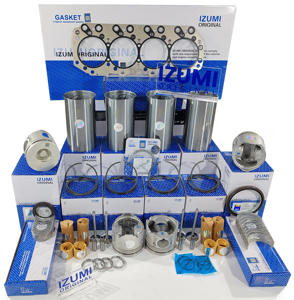
All categories
Featured selections
Trade Assurance
Buyer Central
Help Center
Get the app
Become a supplier

(960 products available)



































A 4za1 engine crankshaft is a mechanical component found in internal combustion engines. It converts the reciprocating motion of the pistons into rotational motion, allowing the engine to power the vehicle.
There are two main types of engine crankshafts:
There are also several variations of the 4za1 engine crankshaft, each designed to meet specific performance and durability requirements:
Regular oil changes
To maintain a healthy 4ZA1 crankshaft, it is essential to perform regular oil changes. Oil changes keep the crankshaft lubricated, reducing wear and tear. Fresh oil circulates through the engine, ensuring all parts receive adequate lubrication. Follow the manufacturer's recommended schedule for oil changes. This is usually every 3000 to 5000 miles. Using high-quality motor oil is important. Choose oil that meets or exceeds the manufacturer's specifications. The new oil coats the crankshaft and connecting rods when the change is made. This prevents damage when starting up. Regular changes keep the 4ZA1 engine running smoothly. Lubrication reduces friction between moving parts. Over time, old oil can break down and lose its protective properties. Regular changes flush out contaminants. These include metal particles and sludge that accumulate. The new oil also helps to absorb and remove these impurities.
Timming belt replacement
Another important aspect of maintaining a 4ZA1 engine crankshaft is timely belt replacement. The timing belt connects the crankshaft to the camshaft. It controls the opening and closing of engine valves. Over time, timing belts wear out and can break. A snapped timing belt can cause serious damage to an engine. It can lead to piston and valve contact. This is costly to repair. To avoid such issues, inspect the timing belt regularly. Look for signs of wear, such as cracks or fraying. Follow the manufacturer's recommended replacement interval, which is typically every 60,000 to 100,000 miles. When replacing the timing belt, use a genuine OEM or high-quality aftermarket part. A new belt ensures proper engine timing, maximizing performance. Along with the new belt, consider replacing the tensioner and idler pulley. These components work with the timing system.
Regular engine tune-ups
Regular engine tune-ups are crucial for maintaining the health of 4ZA1 engine crankshafts. Tune-ups ensure that the engine runs smoothly and efficiently. During a tune-up, spark plugs, filters, and other components are inspected and serviced. Spark plugs are cleaned or replaced to maintain proper ignition. This prevents misfires and uneven engine vibrations. Uneven vibrations can lead to crankshaft damage over time. Air and fuel filters are also inspected. Clogged filters affect engine performance. They can cause strain on the crankshaft. Filters are either cleaned or replaced to ensure smooth airflow and fuel delivery.
Choosing a proper 4za1 engine crankshaft can be a daunting task, but with the right considerations, it becomes an easy task. Here are some tips to help choose the correct 4za1 engine crankshaft:
Replacing an engine crankshaft is a complicated process, but it can be done as a DIY project. Before replacing the crankshaft, it is important to know how to find it. The 4za1 engine crankshaft can be found beneath the Z block. Remove the Z block to access the crankshaft. Once the Z block is removed, the crankshaft will be visible. Before starting the replacement process, ensure that all the necessary tools are available for the job.
Below are the tools needed for replacing the 4za1 engine crankshaft:
Follow the steps below to replace the 4za1 engine crankshaft:
Q1: What is the purpose of the crankshaft in a 4ZAI engine?
A1: The crankshaft in a 4ZA1 engine, like in any other internal combustion engine, serves the essential purpose of converting the reciprocating (back-and-forth) motion of the pistons into rotational motion. This rotational motion ultimately powers the vehicle by allowing the wheels to turn. The crankshaft's design and function are critical for the smooth and efficient operation of the engine.
Q2: Can I use a different crankshaft on a 4ZA1 engine?
A2: While it's technically possible to use a crankshaft from a different engine, it's not recommended. Crankshafts are designed to work with specific engines, taking into account factors like engine size, configuration, and balance. Using a crankshaft that isn't designed for the 4ZA1 engine could lead to imbalances, vibrations, and potentially severe engine damage. It's always best to use the original equipment manufacturer (OEM) crankshaft or a high-quality aftermarket crankshaft specifically designed for the 4ZA1 engine.
Q3: How often does a crankshaft need to be replaced?
A3: Crankshafts are typically designed to last the life of the engine under normal operating conditions. However, factors like engine wear, improper lubrication, or catastrophic engine damage can necessitate a crankshaft replacement. If a crankshaft becomes worn beyond specification (e.g., due to bearing wear) or if it's damaged (e.g., fractured) due to a lack of lubrication or mechanical failure, replacement may be required. Signs of crankshaft issues include engine vibrations, unusual noises, and poor engine performance. If any of these symptoms are observed, it is advisable to seek a mechanic's guidance.
Q4: Can I repair a damaged crankshaft, or does it always need to be replaced?
A4: Whether a crankshaft can be repaired or needs to be replaced depends on the extent and location of the damage. Minor surface damage (e.g., scratches or dents) may be repaired through grinding or polishing to restore the crankshaft's balance and smooth operation. However, more severe damage (e.g., cracks, fractures, or major bends) usually requires a crankshaft replacement. It's essential to have a qualified mechanic or engine builder assess the crankshaft's condition and recommend the best action.
Q5: What is the process of crankshaft replacement?
A5: Crankshaft replacement involves several steps, including: